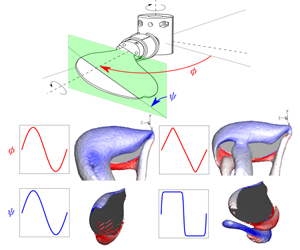Published online by Cambridge University Press: 03 December 2019

Flapping wings of insects can follow various complex-motion waveforms, influencing the flow structures over a wing and consequently the aerodynamic performance. However, most studies of insect-wing models incorporate either simple harmonic or robofly-like motion waveforms. The effects of other waveforms appear to be under-explored. Motivated by this, the present study investigates the individual and combined effects of the sweep- and pitch-motion waveforms for fixed flapping frequency and amplitude of a fruit-fly wing planform. Physical experiments are conducted to directly measure the forces and torques acting on the wing. Interestingly, the sweep waveform is observed to influence the overall variation in the lift coefficient ( $C_{L}$), whereas the pitch waveform is observed to influence only the instantaneous
$C_{L}$), whereas the pitch waveform is observed to influence only the instantaneous  $C_{L}$ during stroke reversal. Carefully validated three-dimensional numerical simulations reveal that a change in the strength of the large-scale vortex over the wing as the sweep profile parameter is varied is responsible for the observed variations in
$C_{L}$ during stroke reversal. Carefully validated three-dimensional numerical simulations reveal that a change in the strength of the large-scale vortex over the wing as the sweep profile parameter is varied is responsible for the observed variations in  $C_{L}$. An exploration over wide ranges of the sweep and the pitch profile parameters shows that the waveforms maximising the mean lift coefficient are different from those maximising the power economy. Consistent with some previous experiments on robotic insects, the possibility of passive pitch motion is observed at slower pitching rates. Contours of the mean lift coefficient and power economy mapped on the planes of the sweep and the pitch profile parameters can help designers of flapping-wing micro air vehicles in selecting the waveforms appropriate for their design criteria.
$C_{L}$. An exploration over wide ranges of the sweep and the pitch profile parameters shows that the waveforms maximising the mean lift coefficient are different from those maximising the power economy. Consistent with some previous experiments on robotic insects, the possibility of passive pitch motion is observed at slower pitching rates. Contours of the mean lift coefficient and power economy mapped on the planes of the sweep and the pitch profile parameters can help designers of flapping-wing micro air vehicles in selecting the waveforms appropriate for their design criteria.
The flow structures over a flapping wing, identified using the iso-Q surfaces and coloured by the normalised spanwise vorticity, are shown for the sweep motion parameters K=0.01 (top) and K=0.99 (bottom). The corresponding variation in the lift coefficient with time is also shown in each case.
The flow structures over a flapping wing, identified using the iso-Q surfaces and coloured by the normalised spanwise vorticity, are shown for the pitch motion parameters C_\psi=0.01 (top) and C_\psi=8 (bottom). The vorticity contours on the spanwise plane at the midspan location are shown in the right column along with the time traces of the lift coefficient.